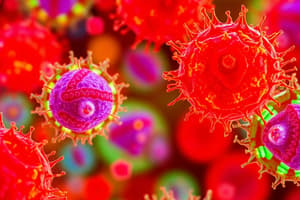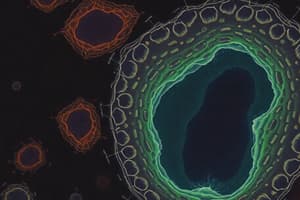Podcast
Questions and Answers
Which characteristic of life refers to an increase in size?
Which characteristic of life refers to an increase in size?
- Responsiveness
- Metabolism
- Growth (correct)
- Reproduction
What structure is firmly attached to the surface of bacterial cells and provides protection?
What structure is firmly attached to the surface of bacterial cells and provides protection?
- Cytoplasm
- Capsule (correct)
- Slime layer
- Cell membrane
Which of the following statements best describes the slime layer of bacterial cells?
Which of the following statements best describes the slime layer of bacterial cells?
- It is loosely attached and helps bacteria to adhere to surfaces. (correct)
- It is composed of polysaccharides and offers firm protection.
- It prevents the bacteria from reproducing.
- It is tightly bound and provides structural support.
What type of cells are characterized by a membrane-bound structure capable of carrying out all functions of life?
What type of cells are characterized by a membrane-bound structure capable of carrying out all functions of life?
In terms of cellular structure, what is a primary characteristic of prokaryotic cells?
In terms of cellular structure, what is a primary characteristic of prokaryotic cells?
What is the primary function of bacterial flagella?
What is the primary function of bacterial flagella?
Which structure is used by bacteria to adhere to one another and to substances in the environment?
Which structure is used by bacteria to adhere to one another and to substances in the environment?
Which type of bacteria is characterized by a thick layer of peptidoglycan?
Which type of bacteria is characterized by a thick layer of peptidoglycan?
What component of Gram-negative bacteria can cause inflammatory responses in the host?
What component of Gram-negative bacteria can cause inflammatory responses in the host?
What is the function of bacterial cell walls?
What is the function of bacterial cell walls?
Which type of bacterium typically has only one or a few conjugation pili per cell?
Which type of bacterium typically has only one or a few conjugation pili per cell?
Which of the following is a characteristic of Gram-negative bacteria?
Which of the following is a characteristic of Gram-negative bacteria?
Which bacteria lack cell walls and can cause urogenital infections?
Which bacteria lack cell walls and can cause urogenital infections?
Which structure serves as the anchoring mechanism for bacterial flagella?
Which structure serves as the anchoring mechanism for bacterial flagella?
What is a significant feature of mycobacterium that helps prevent drying out?
What is a significant feature of mycobacterium that helps prevent drying out?
What is the primary function of ATP-dependent carrier proteins in bacterial cytoplasmic membranes?
What is the primary function of ATP-dependent carrier proteins in bacterial cytoplasmic membranes?
Which of the following processes involves the chemical modification of a substance during transport?
Which of the following processes involves the chemical modification of a substance during transport?
What is the major component of bacterial ribosomes?
What is the major component of bacterial ribosomes?
Which of the following bacteria is NOT known to form endospores?
Which of the following bacteria is NOT known to form endospores?
What unique feature do archaeal cell walls commonly have compared to bacterial cell walls?
What unique feature do archaeal cell walls commonly have compared to bacterial cell walls?
What role does the glycocalyx play in prokaryotic cells?
What role does the glycocalyx play in prokaryotic cells?
What feature distinguishes eukaryotic flagella from prokaryotic flagella?
What feature distinguishes eukaryotic flagella from prokaryotic flagella?
Which structure in bacterial cytoplasm contains the cell's DNA?
Which structure in bacterial cytoplasm contains the cell's DNA?
Which type of transport mechanism involves moving substances against their concentration gradient?
Which type of transport mechanism involves moving substances against their concentration gradient?
What is the purpose of archaea having cytoplasmic membranes?
What is the purpose of archaea having cytoplasmic membranes?
Which of the following eukaryotic structures is primarily used for movement?
Which of the following eukaryotic structures is primarily used for movement?
Which statement about bacterial endospores is true?
Which statement about bacterial endospores is true?
What defines eukaryotic cell walls in plants?
What defines eukaryotic cell walls in plants?
Flashcards
Characteristics of Life
Characteristics of Life
Essential traits that define living organisms including growth, reproduction, responsiveness, metabolism, and cellular structure.
Prokaryotic Cells
Prokaryotic Cells
Simple, single-celled organisms without a nucleus, such as bacteria.
Eukaryotic Cells
Eukaryotic Cells
More complex cells with a nucleus and organelles, found in plants, animals, and fungi.
Capsule (Bacteria)
Capsule (Bacteria)
Signup and view all the flashcards
Slime Layer (Bacteria)
Slime Layer (Bacteria)
Signup and view all the flashcards
Flagella
Flagella
Signup and view all the flashcards
Taxis
Taxis
Signup and view all the flashcards
Fimbriae
Fimbriae
Signup and view all the flashcards
Pili
Pili
Signup and view all the flashcards
Peptidoglycan
Peptidoglycan
Signup and view all the flashcards
Gram-positive bacteria
Gram-positive bacteria
Signup and view all the flashcards
Gram-negative bacteria
Gram-negative bacteria
Signup and view all the flashcards
Mycobacterium
Mycobacterium
Signup and view all the flashcards
Conjugation
Conjugation
Signup and view all the flashcards
Bacteria without cell walls
Bacteria without cell walls
Signup and view all the flashcards
Bacterial Cytoplasmic Membrane
Bacterial Cytoplasmic Membrane
Signup and view all the flashcards
Active Transport
Active Transport
Signup and view all the flashcards
Group Translocation
Group Translocation
Signup and view all the flashcards
Nucleoid
Nucleoid
Signup and view all the flashcards
Endospores
Endospores
Signup and view all the flashcards
Clostridium tetani
Clostridium tetani
Signup and view all the flashcards
Ribosomes
Ribosomes
Signup and view all the flashcards
Glycocalyces in Archaea
Glycocalyces in Archaea
Signup and view all the flashcards
Archaeal Cell Wall
Archaeal Cell Wall
Signup and view all the flashcards
Eukaryotic Glycocalyces
Eukaryotic Glycocalyces
Signup and view all the flashcards
Eukaryotic Cell Walls
Eukaryotic Cell Walls
Signup and view all the flashcards
Cytoplasmic Membranes in Eukaryotes
Cytoplasmic Membranes in Eukaryotes
Signup and view all the flashcards
Eukaryotic Flagella
Eukaryotic Flagella
Signup and view all the flashcards
Eukaryotic Cilia
Eukaryotic Cilia
Signup and view all the flashcards
Inclusions
Inclusions
Signup and view all the flashcards
Study Notes
Characteristics of Life
- Growth involves an increase in size
- Reproduction involves an increase in number (cell division)
- Responsiveness is reacting to environmental stimuli
- Metabolism involves controlled chemical reactions
- Cellular structure is a membrane-bound structure capable of performing all life functions
Prokaryotic Cells
- Figure 3.2 shows a typical prokaryotic cell
- Key components include ribosomes, cytoplasm, nucleoid, glycocalyx, cell wall, and cytoplasmic membrane. Inclusions may also be present.
Eukaryotic Cells
- Figure 3.3 depicts a typical eukaryotic cell highlighting the nucleus, nucleolus, cilia, ribosomes, lysosome, mitochondria, centriole, secretory vesicles, Golgi body, transport vesicles, rough endoplasmic reticulum, smooth endoplasmic reticulum, cytoplasmic membrane and cytoskeleton.
- Eukaryotic cells are larger than prokaryotic cells as seen in figure 3.4
- A chicken egg measures 4.7 cm in diameter (47,000 μm)
- A virus (orthopoxvirus) is 0.3 μm in diameter
- A bacterium (Staphylococcus) is 1 μm in diameter
- A parasitic protozoan (Giardia) is 14 μm in length
Bacterial Cells - Glycocalyces
- Capsules composed of polysaccharides are firmly attached to the cell surface providing protection. (e.g., Streptococcus pneumonia)
- Figure 3.5 shows glycocalyces in (a) and (b)
- Slime layers are loosely attached to the cell surface, creating a sticky layer that allows prokaryotes to attach to surfaces (e.g., Pseudomonas spp.)
Bacterial Cells - Flagella
- Responsible for bacterial motility, if present
- Composed of filament, hook, and basal body
- Basal body anchors the filament and hook to the cell wall
- Figure 3.6 shows the structure, (a) and (b), of bacterial flagella
- Types include monotrichous, amphitrichous, lophotrichous, and peritrichous
- Rotation propels the bacterium through the environment
- Bacteria move in response to stimuli (taxis) with runs (counterclockwise) and tumbles (clockwise) as shown by figure 3.9
Bacterial Cells - Axial Filaments (Spirochetes) - Endoflagella
- Axial filaments allow spirochetes to corkscrew and move forward (Figure 3.8)
- Endoflagella rotate, causing the axial filament to rotate around the cell.
Bacterial Cells - Fimbriae
- Sticky, bristle-like projections shorter than flagella
- Used by bacteria to attach to one another and to substances in the environment (Figure 3.10)
Bacterial Cells - Pili
- Special type of fimbriae longer than fimbriae
- Conjugation pili transfer DNA between cells (Figure 3.12)
Bacterial Cell Walls
- Provide characteristic shapes to bacterial cells
- Protect cells from osmotic forces
- Assist some cells in attaching to other cells
- Antibiotics may disrupt the cell wall (CW).
- Shapes include cocci (spherical), chains (strepto), clusters (staphylo), cuboidal packets (sarcinae), and rods (bacilli) shown in figure 3.13
- Composed of peptidoglycan
- Two basic types:
- Gram-positive: thick layer of peptidoglycan
- Gram-negative: thin layer of peptidoglycan (figure 3.15)
- Peptidoglycan structure (figure 3.16). It is composed of millions of NAG and NAM sugars with tetrapeptide amino acid crossbridges
- Gram-positive bacteria appear purple after Gram staining, while gram-negative bacteria appear pink. Figure 3.16a and 3.16b. This is helpful for classifying bacteria.
Gram-variable Bacteria
- Mycobacterium: causative agent of leprosy and tuberculosis. Have up to 60% mycolic acid (lipid) in their walls.
Gram-negative Bacteria
- Thin layer of peptidoglycan, with outer bilayer membrane (phospholipids, proteins, LPS; Lipid A portion causes inflammation, shock).
- May impede disease treatment
- Appear pink after Gram staining
Bacteria Without Cell Walls
- Some bacteria lack cell walls: Ureaplasmas (cause urogenital infections), Mycoplasmas (cause atypical walking pneumonia).
Bacterial Cytoplasmic Membranes
- Arranged in a bilayer of phospholipids and hopanoids (stabilize the membrane)
- Contain integral and peripheral proteins.
- Active processes: Active transport uses ATP-dependent carrier proteins to transport substances into the cell
- Group translocation involves chemically modifying substances during transport (e.g., glucose, mannose, fructose, seen in figure 3.23)
Cytoplasm of Bacteria
- Cytosol contains DNA in a region called the nucleoid.
- The liquid portion of the cytoplasm is mostly water.
- Inclusions may include reserve deposits of chemicals and nutrients (e.g., Figure 3.24, showing polyhydroxybutyrate)
Endospores
- Unique structures produced by some bacteria as a defensive strategy against unfavorable conditions such as heat, radiation, and chemicals.
- Resistant to extreme conditions
- Examples are Bacillus anthracis and Clostridium spp. (Figure 3.25)
Clinically Important Endospore-forming Bacteria
- Medically relevant examples of endospore-forming bacteria are species within Bacillus and Clostridium genera including: Clostridium tetani, Clostridium botulinum, Clostridium perfringens, Clostridium difficile, and Bacillus anthracis.
- Endospores survive for extended periods on surfaces, even in healthcare facilities.
Components of Bacterial Cells
- Ribosomes: sites of protein synthesis (drugs act on 70S ribosomes) composed of polypeptides and ribosomal RNA.
Archaea – External Structures
- Glycocalyces: Function in biofilm formation and adherence
- Flagella: For motility
- Fimbriae: Non-motile, rod-shaped, sticky projections, possibly with hami (hooks) for attachment to surfaces
Archaeal Cell Wall and CM
- Most archaea have cell walls containing specialized polysaccharides and proteins
- All archaea have cytoplasmic membranes that maintain electrical and chemical gradients, controlling substance import/export
Eukaryotic Cells – External Structures
- Glycocalyces: Present in wall-less eukaryotic cells (not as organized), reinforcing cell surfaces, protecting against dehydration, and playing a role in cell-to-cell recognition and communication
- Eukaryotic Cell Walls: Found in fungi, algae, and plants, composed of various polysaccharides.
- Eukaryotic Cytoplasmic Membranes: All eukaryotic cells have cytoplasmic membranes, regulating substance movement and containing regions of lipids and proteins (membrane rafts)
Eukaryotic Flagella
- Differ structurally and functionally from prokaryotic flagella
- Found within the cytoplasmic membrane
- Can be single or multiple, generally at one pole of the cell
Eukaryotic Cilia
- Shorter and more numerous than flagella
- Coordinated beating propels cells through their environment and moves substances across the cell's surface
Eukaryotic Ribosomes
- Larger than prokaryotic ribosomes (80S versus 70S)
Studying That Suits You
Use AI to generate personalized quizzes and flashcards to suit your learning preferences.




